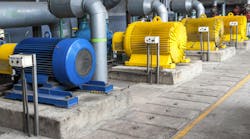The Roots-style blower was first introduced in the mid-19th Century, intended for use as an air pump in blast furnaces and other industrial applications. Today, they are used in industrial, automotive, and marine applications, as well as in fuel cell electric vehicles as pumps for air and liquid hydrogen.
The supercharger works by pulling air through a pair of smoothly meshing rotors that turn in opposite directions. Air is trapped in the pockets formed between the rotors and the housing. As those opposing rotors turn, pressure differentials build up in the expanding and collapsing pockets. For every revolution of the rotor, air gets pumped from one side of the unit to the other, from inlet to outlet. Timing gears are typically used to keep the rotors synchronized.
The TX series from Ogura uses a specialized coating that can absorb metal chips. The chips become embedded in the coating instead of scoring and scratching the inner housing or getting transferred into the engine. The ability of this coating to absorb small amounts of material contamination helps maintain blower efficiency.
Another unique design feature of the Ogura TX superchargers is the use of hollow, low-inertia rotors. This allows for an electric clutch to be used on the input side so that the supercharger can be engaged remotely. The lightweight rotors mean that the supercharger can ramp up and apply boost very quickly. The TX series also has an optional electric clutch, which reduces energy consumption: The blower doesn’t turn when it isn’t needed (in the process, extending the life of the supercharger). The electric clutch also allows the supercharger to be engaged remotely at any time.
The high efficiency of the Ogura designed Roots blowers is being realized across many other applications including mobile agricultural sprayers, mobile vacuum equipment, drying processes, exhaust gas recirculation, stationary power generation, industrial furnaces, and fuel cell applications.


